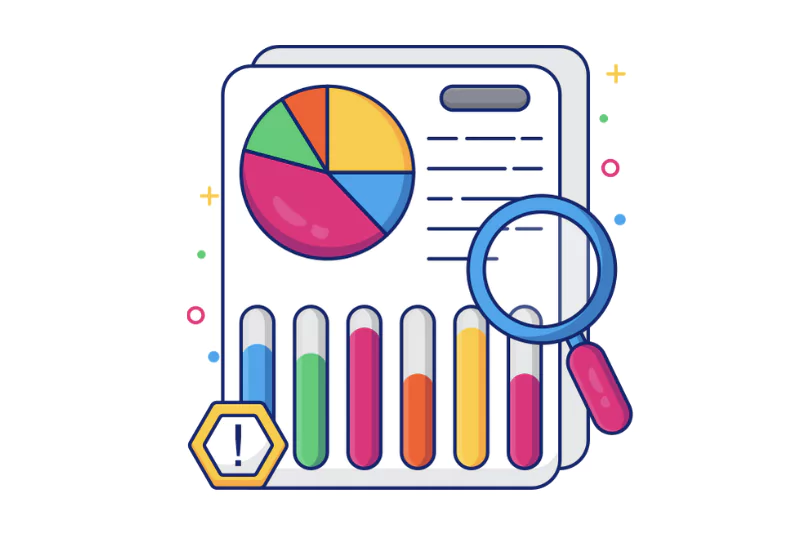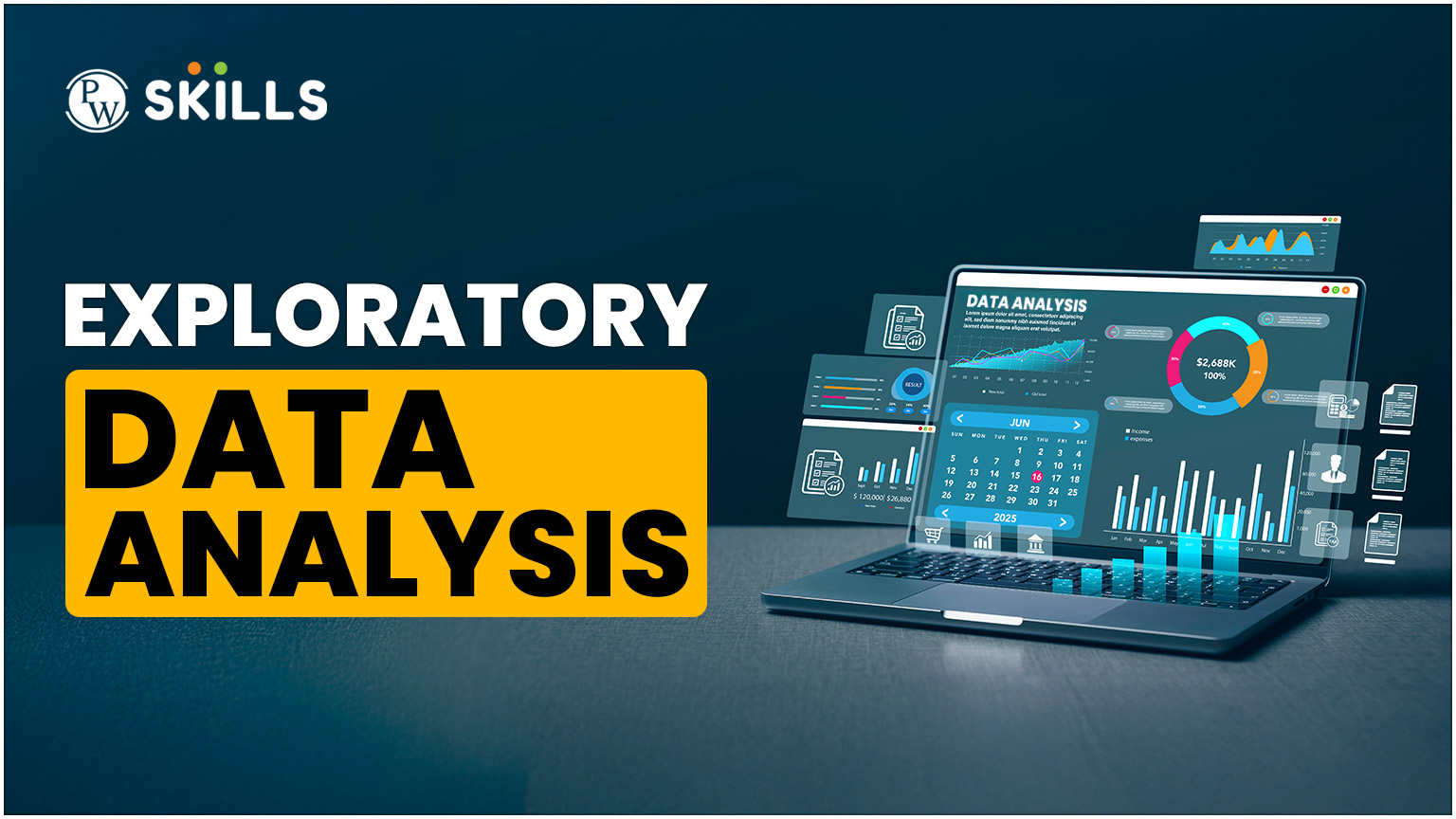Exploratory data analysis sounds like an advanced analytics approach as it is a method which is used to find patterns in a dataset, analyse and summarise them to reach a perfect set of conclusions. Many of the experts are confused about the difference between a normal data analysis and data analysis with a prefix exploratory in its name.
In exploratory data analysis, we understand data, visualize it and find the patterns beneath the dataset. In this tutorial, we will be learning about Exploratory data analysis in detail.
Exploratory Data Analysis Meaning
The real meaning of exploratory data analysis lies in its approach to handling analytics with a fusion of in-depth understanding of dataset structure, patterns, uncovering patterns and insights to perform a more advanced analysis approach on the dataset.

EDA explores the patterns, characteristics, relationships, and more which helps in data preparation, decision making, strategic approach, hypothesis generation, and more.
Exploratory Data Analysis: Key Takeaways
- Exploratory data analysis can be used to identify errors, relationships, understand patterns, within the data.
- Univariable Non-Graphic Data analysis, Univariate Graphical analysis, Multi-Variate Analysis, Graphical Analysis, are some of the types of EDA.
- Exploratory analysis is used by data scientists to ensure the results they produce are applicable for business goals.
- With EDA you can answer questions like confidence retrieval, categorical variables, standard deviations, and more.
Why Do We Need Exploratory Data Analysis?

Exploratory Data Analysis is important for so many reasons, let us know about some of the most important parts of EDM below.
- EDM helps you understand the dataset including the features, types, data spreads, and more.
- Exploratory data analysis helps you choose the right statistical model for the analysis purpose based on proper in-depth analysis.
- With the help of EDA we can easily find hidden patterns, relationships between datasets. This helps in building model and analysis purposes.
- Exploratory data analysis helps us spot any kind of missing values, typos, anomalies, incorrect data which can have adverse impact on the data.
- You can use EDA to plot and discover patterns and relationships between variables.
- You can validate assumptions for statistical tests or modeling using Exploratory data analysis.
- You can understand the best exploratory data analysis techniques and models to improve performance.
How to Perform Exploratory Data Analysis?

There are a series of steps which you must consider while performing exploratory data analysis. It includes finding patterns, anomalies, hypotheses, cleaning data, and more for further analysis.
1. Get to the Problem and the Data
The first step in the way is that you understand the problem statement and the kind of resources or data you have. It is important to ask yourself plenty of questions regarding your goals and data availability.
You can better plan the data preparation, analysis, avoid wrong assumptions, and ensure that you reach correct conclusions. Some of the major questions that you can rectify before starting with EDA are
- Do you have sufficient data?
- What is your business goal and question?
- What are the variables in data type?
- What are the types of data you are working on?
2. Import and Inspect Available Data
When you get the data your next step will be to import the data for analysis purposes using tools like Python, R and more. You will examine the data to get a proper understanding of its structure, types and issues.
Load your data into the environment safely, examine the size of the data and check for any missing values if they are on the sheet. Analyse the type of data which will help in data manipulation and analysis purpose. You will have to look for errors and look for any inconsistencies in data.
3. Handle Missing Values
Make sure you do not leave the missing data as it affects the quality of your analysis. It is important to identify the issues, handle missing data in the dataset to avoid biased on misleading results.
Make sure you understand the pattern, and decide whether you need to remove the missing value slot or you just want to replace it using some imputation methods like mean, medium, regression, machine learning algorithms, decision trees, KNN, and more. If you properly handle the missing data the accuracy of your analysis will be accurate and free from any misleading conclusions.
4. Know More About Data
When you address the missing data you can use EDA to explore the characteristics of the data by using various methods like Data distributions, central tendency, variability, outliers, anomalies, and more. This will help you make proper selection for analysis purposes and help you spot any potential data issues.
5. Ensure Data Transformation
Make sure you provide the way for accurate analysis and modeling by carefully going through the data characteristics and analysis methods. You can transform the data to ensure it is available in the right format.
You can use the following transformations to convert your data using the following ways.
- Scaling or Normalising
- Encoding variables
- Mathematical Transformation
- Create New Variables
- Aggregating Data
6. Visualize Relationship Within Data
Visualization is a powerful tool in Exploratory analysis method which can help you uncover relationships and identify patterns in the data. You can use frequency tables, bar plots, pie charts, and other methods to identify the imbalances and unusual patterns.
For analysis of numerical values you can use histograms, density plots, box plots, and more to visualize distribution, shape, spread, and other outliers. You can also explore relationships between variables using correlation metrics or statistical tests.
7. Handle Outliers
When you make mistakes in measuring or entering data then you can possibly give rise to outliers which can be very important to handle because of its effects on analysis and model performance.
You can easily identify outliers using methods like Z scores, domain specific rules, IQR (Interquartile Range), and more. You can either adjust or remove the outliers based on the context required.
8. Share Insights and Findings
You have to share insights and analysis points in your results in your report, state your goals, provide context and background. You can use visualization to support your finding where you have to highlight key insights, patterns or anomalies in the data analysis report.
Exploratory Data Analysis Tools & Techniques

You can use specific tools which can help you with exploratory data analysis work below.
- You can use predictive models using linear regression, statistics modeling, and data to predict outcomes.
- Use Python libraries like Pandas, NumPy, Matplotlib, Scikit Learn, and more.
- You can use BI tools like Tableau, Looker, Power BI, and etc.
- You can use Jupyter Notebooks or Google Colab, gdb online compiler, and more.
- You can use mean, median, mode, standard deviations for descriptive statistics.
- You can use imputation techniques such as count, null values, and more.
- There are many other EDA techniques which you can such as histograms, pie charts, z-score, scatter plots, correlation matrix, pivot tables, and more.
Types of Exploratory Data Analysis

There are four major methods of classifications in EDA which goes like.
- Univariate Non-Graphical EDA
- Univariate Graphical EDA
- Multi-variate Non-graphical EDA
- Multi-variate graphical EDA
1. Univariate Non-Graphical EDA
This is the primary form of EDA which is used for data analysis for a single variable. It does not involve dealing with relationships or cause. The main objective of Univariate graphical is to describe the data and find important patterns and relationships existing within it.
For example, analyzing the distribution of “Age” in a dataset you can use Univariate Non-graphical EDA.
2. Univariate Graphical EDA
This non graphical method of EDA is used to represent the values and shape of the distributions using Stem and leaf plots, histograms, box plots, and more. You can use it to explore the relationship between two variables.
Some techniques used in this type of EDA analysis are scatter plots, box plots, correlation coefficient, crosstabs, and more. For example, you can investigate the relationship between “Age” and “Income” or “Gender” and “Purchase Decision”.
3. Multi-Variate Analysis
The Multi-variate method is used to analyse more than two variables simultaneously to understand complex relationships. You can use techniques like Pair plots, heatmaps, grouped bar charts, PCA, and multivariate regression.
For example, consider studying how “age”, “Education”, and “Income” influence the “Spending score” of a person and in how many ways.
4. Graphical Analysis
The Graphical Analysis method is used with visual tools which can be used to uncover patterns, trends, and anomalies. The techniques used in this method are bar charts, histograms, KDE plots, Pie charts, and interactive dashboards.
For example, you are using a heatmap to find strong correlations among multiple numeric features using graphical analysis. You can also use other methods like bar charts, heatmaps, pie charts, and more.
Also Read:
- What is the Difference Between Big Data Analytics and Data Analytics?
- What Are Some Common Statistical Measures In Data Analytics?
- What Is The Purpose Of Feature Selection In Data Analytics?
- Time Series Forecasting – Master with These 11 Steps
Learn Data Analysis with PW Skills
Get familiar with the concept of data analysis and techniques with the PW Skills Data Analysis Course. Learn advanced tools like Python, SQL, R, Pandas, and other libraries. Work on industry based projects, practice exercises, module assignments, and more.
You can build a strong portfolio with industry skills in the course. Attain your certification after completing entire course only at pwskills.com
Exploratory Data Analysis FAQs
Q1. What is Exploratory Data Analysis?
Ans: Exploratory Data analysis is an approach which finds patterns and relationships in the data. These patterns are used to include outliers and features of the data which might be unexpected.
Q2. What are the types of Exploratory Data analysis?
Ans: Univariate Non-graphic, Univariate Graphic Analysis, Multi-Variate Analysis, Graphical analysis are some major types of Exploratory data analysis.
Q3. Why do we need an Exploratory Data Science Internship?
Ans: We need EDA to understand the dataset, statistical model for analysis, find patterns, relationship between datasets, find missing values, fix incorrect data or errors, and more.
Q4. What are the EDA examples?
Ans: Suppose you want to improve sales through customer behavior analysis then you can use EDA insights such as best selling products and peak months, customer segments by purchase frequency, average order value over time, detection of return trends or refunds.

